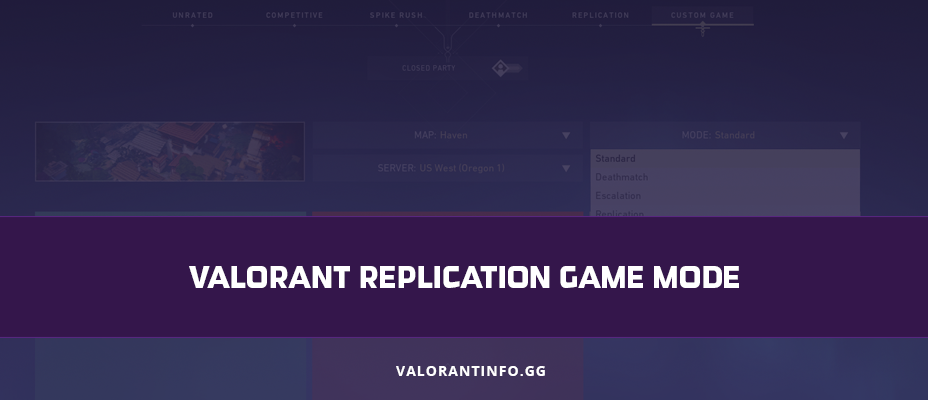Valorant Replication is a 5vs5 Plant/defuse-style game mode with a unique twist – everyone on the same team plays the same character! This change makes for super interesting rounds where you’ll have to devise brand new strategies and tactics to succeed.
Replication was released in May of 2021 and remained one of the most popular game modes because of its uniqueness. If you’d like to know more, then be sure to stick around, as we’re going to cover all aspects of this game mode right here in this article. Let’s get into it.
Plant/Defuse
Replication follows the traditional Plant/defuse style of gameplay that Valorant’s main game modes use. If you’re unfamiliar with this style, let us explain.
In Plant/defuse-style games, one team is the designated attacking team, and one team is on defense. The attacking team has to plant the spike at one of two or three bomb sites on the map, and it’s the defending team’s job to protect the bomb sites and defuse the spike if it gets planted. There are a lot of strategies involved, and there are also no respawns each round, making for some intense gameplay.
Additionally, note that attackers and defenders switch sides halfway through the game. In Replication, this switch happens after round 4.
Now, let’s talk a bit more about how the Valorant Replication game mode works specifically.
Choosing Agents
The agent that your entire team plays is decided through a voting system in the pre-game phase. Here, every player gets one vote and can pick any character that they have unlocked. Once everyone has locked in their votes, a random character is chosen, and the game then begins.
You could be playing an agent you know and love, or you could be stuck with one you’d never dream of picking in a Competitive match, but either way, it doesn’t matter because this game mode is ultimately just about having a good time.
Round Structure
The structure of Replication is similar to Unrated and Competitive, but there are only 4 rounds per half instead of 12. The first team to win 5 rounds is crowned victorious, so expect relatively short games compared to what you might be used to.
Also, if the score reaches 4-4 at the end of round 8, the game doesn’t go into overtime. Instead, it goes into sudden death, where the winner takes all.
Guns & Abilities
When it comes to buying guns and abilities in Replication, there’s a slightly different system in place to what you see in Unrated and Competitive. Instead of receiving varying amounts of money depending on performance, players receive a set amount of money at the start of each round, and abilities are all automatically refreshed. How it works is outlined below:
- Round 1/5: 900 credits. This is essentially a pistol round, but players can buy the Bucky if they want.
- Round 2/6: 2400 credits. Here, players have enough money to buy a range of cheap primary weapons, though most opt for the Spectre with light shields.
- Round 3/7: 3900 credits. This round is essentially a full buy round, where players have enough money to buy themselves almost any weapon. Most players will opt for either a Vandal or Phantom along with heavy shields here.
- Round 4/8/9: 6000 credits. Here, players have enough money to buy any weapon they’d like. This is also the only round where the Operator is available.
Earning Experience Points
Earning experience points in Replication is very similar to what you see in Unrated or Competitive. For every round you play, you earn 100XP, and you gain an additional 200XP per round you win. Pretty cool, right?
Additionally, you can earn progress towards both your daily and weekly challenges in Replication. Just note that any missions that require you to purchase abilities aren’t possible to complete in the Replication game mode alone, as abilities are all automatically bought at the start of each round.
A Limited-Time Game Mode
Unfortunately, Replication is part of the rotating game mode queue alongside Escalation and Snowball Fight, meaning it’s only available to play at certain times. Only one of these three game modes is ever playable at a time, and the featured one changes each patch.
If you don’t see Replication in your game mode list when you log in to Valorant, unfortunately, you’ll have to wait for a patch or two for it to reappear.
Riot decided to put these three game modes in one queue to reduce waiting times from having them split, which is fair enough but still frustrating for specific players.
Valorant Replication Game Mode FAQs
To close out the article, we’re going to go over a few frequently asked questions about the Valorant Replication game mode. Here we go.
Is Replication available to all players?
Yes, Replication is available to all players and doesn’t need to be unlocked. This means new players can jump straight into Replication right after logging in for the first time if it’s currently featured in the rotating game mode queue.
Can I play as an agent I haven’t yet unlocked?
Yes! If another player puts in a vote for an agent you don’t have, and it gets selected, then you’ll get to play as that agent.
What map is Replication played on?
Replication can occur in any one of Valorant’s maps, chosen randomly. Currently, there are 7 maps available: Ascent, Bind, Breeze, Fracture, Haven, Icebox, Split. The Range (practice area) is not included.
Wrapping Up the Valorant Replication Game Mode
Well, there you have it, that’s the end of our overview of the Valorant Replication game mode. This is by far one of the quirkiest and most enjoyable modes in Valorant, so definitely consider giving it a go some time if you haven’t already. Why not invite some friends along too?
Thanks for reading!
